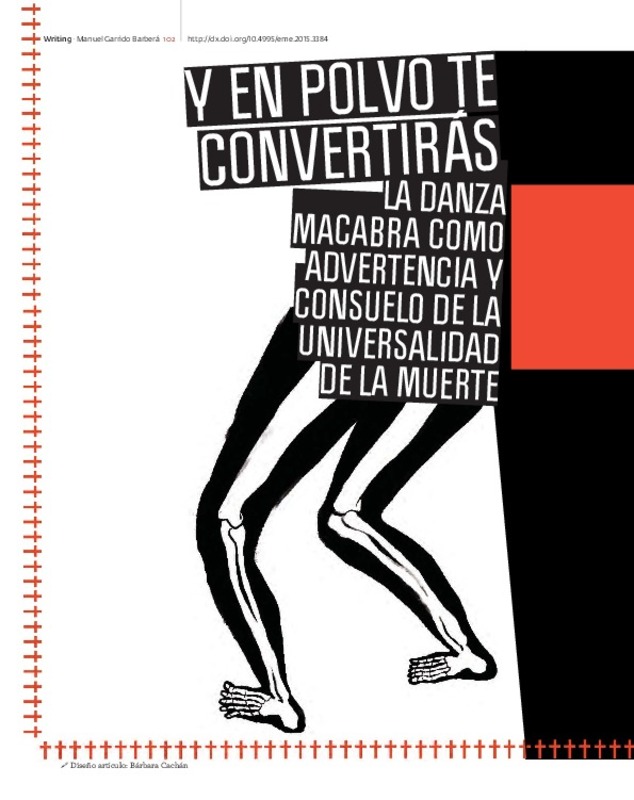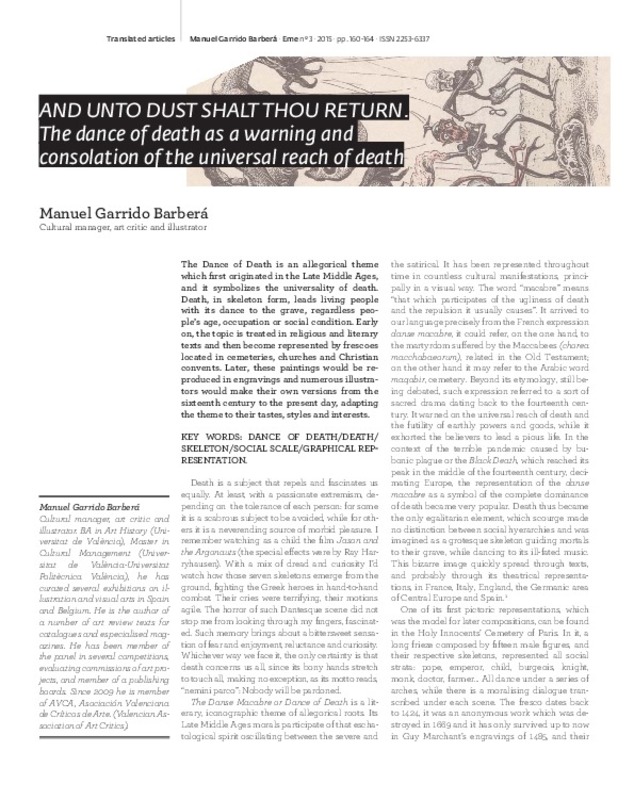JavaScript is disabled for your browser. Some features of this site may not work without it.
Buscar en RiuNet
Listar
Mi cuenta
Estadísticas
Ayuda RiuNet
Admin. UPV
Y en polvo te convertirás. La Danza Macabra como advertencia y consuelo de la universalidad de la muerte
Mostrar el registro sencillo del ítem
Ficheros en el ítem
| dc.contributor.author | Garrido Barbera, Manuel
|
es_ES |
| dc.date.accessioned | 2017-01-13T09:07:23Z | |
| dc.date.available | 2017-01-13T09:07:23Z | |
| dc.date.issued | 2015-04-30 | |
| dc.identifier.issn | 2253-6337 | |
| dc.identifier.uri | http://hdl.handle.net/10251/76740 | |
| dc.description.abstract | [EN] The Dance of Death is an allegorical theme which first originated in the Late Middle Ages, and it symbolizes the universality of death. Death, in skeleton form, leads living people with its dance to the grave, regardless peo-ple’s age, occupation or social condition. Early on, the topic is treated in religious and literary texts and then become represented by frescoes located in cemeteries, churches and Christian convents. Later, these paintings would be re-produced in engravings and numerous illustra-tors would make their own versions from the sixteenth century to the present day, adapting the theme to their tastes, styles and interests | es_ES |
| dc.description.abstract | [ES] La Danza Macabra es un tema alegórico de origen tardomedieval que simboliza la universalidad de la muerte. Ésta, en forma de esqueleto, dirige a los vivos con su baile hacia la tumba independientemente de las sus edades, oficios o condiciones sociales de éstos. Desde temprano, el tema pasa de ser tratado en textos religioso-literarios a ser representado mediante pinturas al fresco ubicadas en cementerios, iglesias y conventos cristianos. Poco después, estas pinturas serían reproducidas en grabado y numerosos ilustradores realizarían sus propias versiones desde el siglo XVI hasta nuestros días, adaptando el tema a sus gustos, estilos e intereses | es_ES |
| dc.language | Español | es_ES |
| dc.language | Inglés | es_ES |
| dc.publisher | Universitat Politècnica de València | |
| dc.relation.ispartof | EME Experimental Illustration, Art & Design | |
| dc.rights | Reconocimiento - No comercial (by-nc) | es_ES |
| dc.subject | Death | es_ES |
| dc.subject | Skeleton | es_ES |
| dc.subject | Social Scale | es_ES |
| dc.subject | Representation | es_ES |
| dc.subject | Dance of death | es_ES |
| dc.subject | Danza macabra | es_ES |
| dc.subject | Muerte | es_ES |
| dc.subject | Esqueleto | es_ES |
| dc.subject | Arte | es_ES |
| dc.subject | Art | es_ES |
| dc.subject | Jerarquía social | es_ES |
| dc.subject | Representación gráfica | es_ES |
| dc.title | Y en polvo te convertirás. La Danza Macabra como advertencia y consuelo de la universalidad de la muerte | es_ES |
| dc.title.alternative | AND UNTO DUST SHALT THOU RETURN.The dance of death as a warning and consolation of the universal reach of death | es_ES |
| dc.type | Artículo | es_ES |
| dc.date.updated | 2017-01-12T13:36:35Z | |
| dc.identifier.doi | 10.4995/eme.2015.3384 | |
| dc.rights.accessRights | Abierto | es_ES |
| dc.description.bibliographicCitation | Garrido Barbera, M. (2015). Y en polvo te convertirás. La Danza Macabra como advertencia y consuelo de la universalidad de la muerte. EME Experimental Illustration, Art & Design. (3):102-117. https://doi.org/10.4995/eme.2015.3384 | es_ES |
| dc.description.accrualMethod | SWORD | es_ES |
| dc.relation.publisherversion | https://doi.org/10.4995/eme.2015.3384 | es_ES |
| dc.description.upvformatpinicio | 102 | es_ES |
| dc.description.upvformatpfin | 117 | es_ES |
| dc.type.version | info:eu-repo/semantics/publishedVersion | es_ES |
| dc.description.issue | 3 | |
| dc.identifier.eissn | 2341-3018 | |
| dc.description.references | BARJA, JUAN; CALATRAVA, JUAN: Hans Holbein. La danza de la Muerte, Madrid, Abada Editores, 2008. | es_ES |
| dc.description.references | FEIN, DAVID A.: Guyot Marchant's Danse Macabre. The Relationship Between Image and Text, 2000 . [Última consulta: 15/10/2014]. | es_ES |









